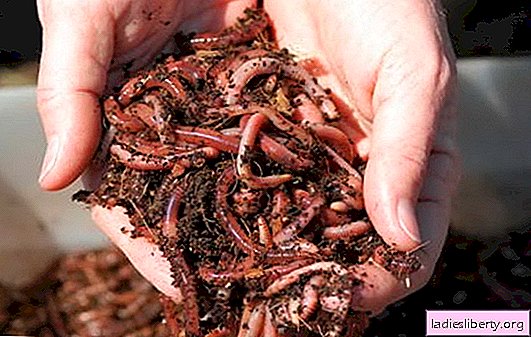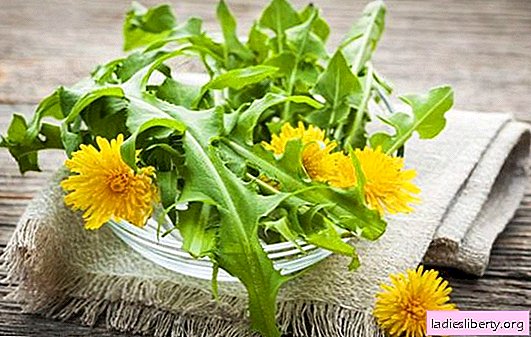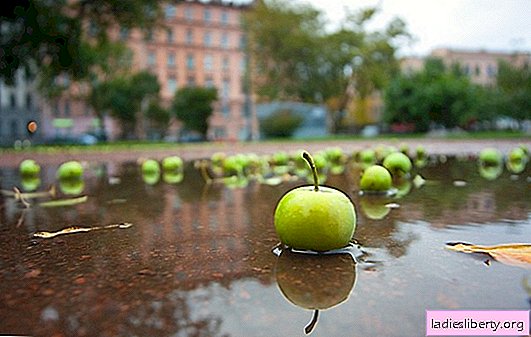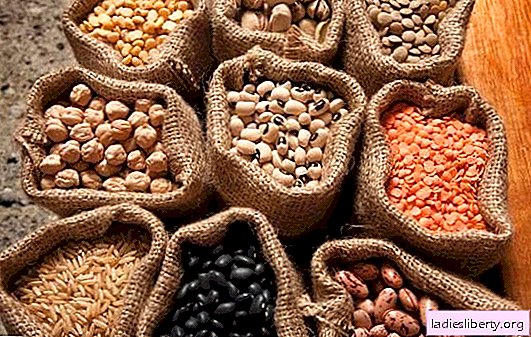
People throw a lot of food waste every day in landfills.
Without much difficulty, a family of 3 can only use kitchen worms during the winter, using worms, to get about 150 kg of effective fertilizer.
This amount of biohumus is enough for both indoor plants and for feeding garden and garden crops.
Why breed worms at home
For fertilizing plants in the beds. Organic fertilizer with high value - vermicompost is useful for both ordinary gardeners and farmers. This fertilizer increases fertility and improves the structure of the soil, enriches it with the most important macro and microelements. Try using vermicompost at least in small quantities in your garden or garden.

Substrate with Worms
For plants, they are still preparing worm tea, a composition that even makes it possible to double productivity. This natural fertilizer is fed plants growing in the room and in the open ground.
For fishermen. It is difficult to find a fisherman who does not use worms while fishing, they sometimes have to look for a long time. Most of them get bait in the markets or in stores, sometimes spending considerable amounts. And for ordinary fishing, at least 30 worms are required. The conclusion about the profitability of growing your own bait is obvious.
Pets. Aquarium fish, birds, and other residents of the home zoo need live feed every day.
For fish farming in the garden pond. Owners of ponds in their area need live feed. The value of worms for feeding fish will be confirmed by any ichthyologist.
Growing earthworms makes it possible to obtain highly effective fertilizer from organic waste and grow a useful supplement to the diet of poultry and animals. Medicine is also interested in the biomass of worms for the production of drugs. The best worm breeds for home breeding are
1. The worm is a prospector;
2. Red California worm.
When acquiring breeding stock, pay attention to the mobility of individuals and their color.
A ton of organics after processing by worms delivers about 100 kg of worms and about 600 kg of vermicompost. Worms contain the most important amino acids, they contain many trace elements, vitamins and enzymes. But 1 ha of the most fertile soil cannot be compared with a hectare of plantation of earthworms in terms of protein yield. Worm meal is eaten well by cattle, pond fish, chickens, pigs, both boiled and raw. The meat of animals obtained by such fattening is obtained of high quality.
In the production of protein flour, a lot of worms are sieved from the substrate, washed, dried, and then ground. In terms of the set of amino acids, this flour is close to meat, but it contains significantly more essential amino acids. When flour from worms is added to the diet of poultry, the number of laid eggs increases by 25%. The growth of fish when feeding worms reaches 33.5%.
Red worm flour is added to aquariums in the form of a special paste, both ordinary and tropical fish are very fond of such feeding.
Worm breeding at home: essential equipment
To obtain worms, you can use almost any room with normal humidity and heating in cold weather:
• Household buildings;
• Attic;
• cellar;
• Garage.
The air temperature in the room should not fall below 4 degrees, otherwise the worms will fall asleep, if the temperature is 36 degrees, then all individuals will die.
To grow earthworms at home, you can use different types of them.
Local earthworm. This variety is maximally adapted to the climatic conditions of your area, they are mainly used due to the fact that they quickly get used to living conditions in a closed farm. Their disadvantage is that the vital activity of this species is lower than that of the "thoroughbred" individuals.
California Red Worm. A common worm species for breeding requires a breeding stock of at least 1,500 individuals. The species is undemanding to the soil mixture, reacts poorly to temperature drops below 10 degrees Celsius, produces high-quality biohumus, and multiplies rapidly.
Worm Miner. The main rival of a California relative. It reproduces well at temperatures between 9-28 degrees, it is a very active species, it increases biomass well and processes the substrate efficiently.
Worm breeding at home: essential equipment

Factory Vermicomposter
For a small vermiferm you need a little inventory:
1. Thermometer;
2. A device for measuring soil acidity;
3. Shelving;
4. Pitchfork;
5. Shovel;
6. Bucket;
7. Wheelbarrow;
8. Sieve;
9. scales.
The main thing is to properly organize boxes, pits or piles for breeding worms and preparing a suitable mixture of organic materials:
Wooden box. Dimensions - 0.5x2x1 m, the capacity is made of boards with a thickness of 25 mm, holes are drilled at the bottom to drain valuable liquid - vermicum. A pallet is placed at the bottom of the box, the lid is made of downed boards or plywood, and ventilation holes are also drilled.
Old fridge. Dismantle all the "insides" of the unit, set up the door with a slight slope, and drill holes for ventilation.
Cardboard box. A convenient option to start breeding worms. Dimensions - 300x400 mm environmentally friendly and "breathable" material. Worms eat small pieces of cardboard, after the box gets wet and becomes thin, they change it.
Plastic container. A prerequisite in this case is unhindered access of fresh air and good drainage, otherwise worms in too wet soil can suffocate. Place a pallet or basin under the vermicum collection container.

Capacity with substrate
Worm breeding at home: where to start
The activity of earthworms, their ability to reproduce, and the speed of processing the substrate directly depend on the quality of the organic mixture. To successfully breed worms, follow these rules:
• Fill 50% of the capacity with humus, it can be mixed with a small amount of chopped cardboard;
• Moisten the substrate slightly;
• After 2-3 days pass, pierce the soil several times and populate the worms;
• Level the substrate and cover the container;
• After a couple of days, you can start adding fresh organic residues from above.
Always experimentally test earthworms in a small container. Approximately 50-100 individuals are placed in new soil. After one day, make sure they are alive. So you can determine whether the acidity of the new substrate is suitable for your pets.
The most suitable soil indicator for worms is in the range of 6.5-7.5 pH. If several dead worms are detected, this is a clear signal that acidity is not suitable for them.
Acidify the substrate if you add:
1. Vegetable tops;
2. Chopped straw or sawdust.
Acidity can be reduced by adding:
1. Ground limestone;
2. The crushed eggshell;
3. Simple chalk.
Worms eat dead and begin to decay parts of plants.
It is forbidden to add to the substrate:
• Parts of citrus;
• Waste after cutting meat.

Worm breeding tank
Worm breeding at home: why not?
You can not add components that greatly increase acidity to the mixture for feeding worms:
• Kefir - increases the level of acidity, and can cause mold;
• Not crushed peel of fruits and vegetables, large bits (hold in a freezer or grind them in a meat grinder, so the walls of organic cells will be destroyed);
• Fresh manure - it gives off a lot of heat, a temperature increase of up to 70 degrees can occur - as a result, the worms will die.
It is advisable to add to the substrate:
• Potato and cabbage peeling, boiled vegetables and peel of bananas;
• food waste;
• Pieces of baking, stale bread;
• Coffee grounds and tea leaves;
• Water, after washing the container from kefir or sour cream;
• Overripe manure, chicken droppings.
Attention: there is too little nutrient content in the long-dung manure that has lain in the open air.
Add food for the worms only after they have mastered the previous volume. Excess food waste in the substrate can increase its acidity and lead to fermentation.
In order for earthworms to multiply faster, it is desirable to add dairy products to the substrate. The feed must be thoroughly mixed with the soil, and not just scattered over its surface. It is necessary to constantly monitor the humidity of the substrate. Do not place a container with worms close to heating appliances, otherwise they will die. It is possible to contain both earthworms and dung worms in one container; they coexist perfectly together. But to make it more convenient to take care of individuals of different "suits", place them separately.
A container with earthworms does not have an unpleasant odor, but harmful insects can fly into them. The container with the substrate should be well ventilated, with good drainage and minimize the risk of worms spreading. Materials that quickly absorb moisture, such as rotted leaves, peat, moss or coconut fiber, are suitable as drainage.
Feeding earthworms with clippings of fruits and vegetables, especially they like peel bananas and melons. Do not leave the remains of feed not embedded in the substrate, this will become a bait for harmful insects. Worms cannot be fed too abundantly, large doses of food will contaminate the soil mixture, can provoke aversion of worms to food, which can, as a result, destroy your culture. If other living organisms start in the same dish with worms - do not panic. They cannot harm the worms you breed.











